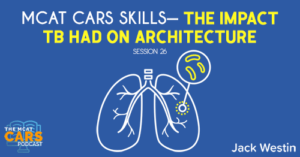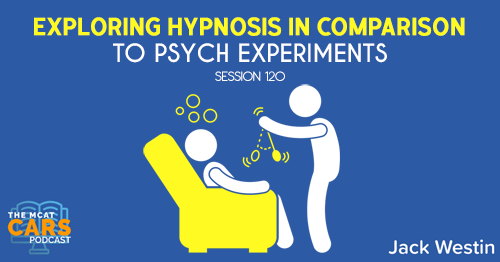Apple Podcasts | Google Podcasts

Session 26
Another week of passage, another week to help you get the MCAT score of your dreams. As always, I’m joined by Jack Westin from JackWestin.com as we dive into this article about tuberculosis and architecture.
Check out Jack Westin and sign up for their daily CARS passages that get sent right to your inbox everyday for free. If you’re looking for more personalized coaching from Jack Westin, check out his MCAT CARS course and get 100% off.
Link to article: https://www.citylab.com/design/2018/10/how-tuberculosis-epidemic-influenced-modernist-architecture/573868/
Since the widespread use of antibiotics to treat tuberculosis started in the 1950s, most people have forgotten about the disease that was, at one point, the deadliest illness in America. But go back two or three generations in your own family, and chances are, you’ll find at least one relative who was affected by tuberculosis, also known as consumption or “the white plague.”
Death rates from TB peaked in the early days of the Industrial Revolution, exacerbated by overcrowding, lack of sanitation, and poor nutrition. Between 1810 and 1815, the disease accounted for more than 25 percent of deaths in New York City. In 1900, it was still the country’s third most common cause of death.
Robert Koch discovered the tubercle bacillus in 1882. As germ theory became better understood, medical professionals knew that isolation was key to prevent the spread of tuberculosis. A person’s best hope for recovery was to live somewhere with plenty of fresh air, sunlight, rest, and nourishing food. The standard of care for TB was primarily environmental—and the design of sanatoria influenced Modernist architecture.
The sanatorium movement began in Europe in the mid-19th century, with resorts in Silesia (now Poland), Germany, and Switzerland. (Davos was once “the tuberculosis capital” of Europe.) Although they began as collections of cottages in mountainous locales, sanatoria evolved into purpose-designed buildings, intended to limit the spread of germs while providing key ingredients for recovery: dry, fresh air and sunshine.
The first tuberculosis sanatorium in the United States was founded by a doctor named Edward Livingston Trudeau—who had consumption himself—in the Adirondacks town of Saranac Lake, New York, in 1885. A key feature of the buildings in Trudeau’s center was a glass-enclosed deck known as a “cure porch.” Tubercular patients would spend much of their time resting on recliners on these porches, even under layers of blankets during the winter months.
The design and construction of specialized sanatoria coincided with the advent of Modernism. Architectural elements like flat roofs, terraces and balconies, and white- or light-painted rooms spread across Europe. Not unlike the sanatorium, the new architecture was intended to cure the perceived physical, nervous, and moral ailments brought on by crowded cities. Part of the appeal of flat roofs was the extra outdoor space they created, which could be used for sunbathing—then known as heliotherapy—and other healthful activities. In 1925, the Swiss architect Le Corbusier dreamed of a city where every citizen’s house was whitewashed and hygienic. “There are no more dirty, dark corners. Everything is shown as it is. Then comes inner cleanliness … .”
[02:55] Paragraph 1, Sentence 1
Since the widespread use of antibiotics to treat tuberculosis started in the 1950s, most people have forgotten about the disease that was, at one point, the deadliest illness in America.
Jack says:
We’re given a background here of what the article is all about.
[03:38] Paragraph 1, Sentence 2
But go back two or three generations in your own family, and chances are, you’ll find at least one relative who was affected by tuberculosis, also known as consumption or “the white plague.”
Jack says:
The author does something interesting here where they call TB a
consumption or “the white plague.” This shows you that they could use different terminologies to express the same thing. This is something the MCAT loves doing. They love using different words to express the same thing. You are now responsible for knowing that TB can also be known as consumption or the white plague. The most apparent use of this is when you’re reading the rest of the passage.
[05:19] Paragraph 2, Sentence 1
Death rates from TB peaked in the early days of the Industrial Revolution, exacerbated by overcrowding, lack of sanitation, and poor nutrition.
Jack says:
Here, they mentioned an abbreviation that wasn’t specified and you’re still responsible for it. In this case, TB means tuberculosis. Make sure you pay attention to what you’ve read before. Always ask yourself why this was mentioned. Another thing, you don’t need to know anything about TB going into this passage. But they tell you some things that can affect your odds of having this disease – overcrowding, lack of sanitation, and poor nutrition. Now that they explained it, they then expect you to know this. They expect you to associate lack of sanitation or poor nutrition to TB.
The MCAT usually asks you differently. For instance, instead of asking specific questions about what was discussed, they ask you about whether or not the discussion is viable. They ask you whether or not it’s worth discussing.
[08:55] Paragraph 2, Sentences 2-3
Between 1810 and 1815, the disease accounted for more than 25 percent of deaths in New York City. In 1900, it was still the country’s third most common cause of death.
Jack says:
They’re giving us numbers here. And they’re saying it’s deadly and common.
[09:29] Paragraph 3, Sentence 1
Robert Koch discovered the tubercle bacillus in 1882.
Jack says:
We’re given a name here. This is probably the source of TB.
[10:05] Paragraph 3, Sentence 2
As germ theory became better understood, medical professionals knew that isolation was key to prevent the spread of tuberculosis.
Jack says:
The term “germ theory” could freak a lot of students out. They’re explaining it to you. It’s probably a theory that you get the disease if you get close to people that have it. And if you’re isolated and away, then maybe TB is prevented. This is all we can use so it’s totally fine if you don’t exactly know what germ theory is.
[11:23] Paragraph 3, Sentence 3
A person’s best hope for recovery was to live somewhere with plenty of fresh air, sunlight, rest, and nourishing food.
Jack says:
It talks about the best way to recover back then when antibiotics still didn’t exist.
[11:45] Paragraph 3, Sentence 4
The standard of care for TB was primarily environmental—and the design of sanatoria influenced Modernist architecture.
Jack says:
This is where it gets hard. They’re giving you a topic that’s common – tuberculosis – something you’re familiar of. Then they relate it to something you’ve never heard of – modernistic architecture. What is that? How does this even relate to tuberculosis? The key word here is “design” where it influences modernist architecture.
You don’t need to know the history of sanatoria but it’s probably like a hospital specifically for long-term illnesses like TB. So you’re able to associate this with recovery. So something about that influences modern architecture.
[13:58] Paragraph 4, Sentence 1
The sanatorium movement began in Europe in the mid-19th century, with resorts in Silesia (now Poland), Germany, and Switzerland.
Jack says:
So they mention this place where they go for recovery. The best thing to do here is to just keep reading and don’t give up halfway through. Don’t get intimated by these new terms. Just keep reading and who knows, it will clear up.
[15:34] Paragraph 4, Sentence 2
(Davos was once “the tuberculosis capital” of Europe.)
Jack says:
They’re just giving you a context here of the place.
[15:44] Paragraph 4, Sentence 3
Although they began as collections of cottages in mountainous locales, sanatoria evolved into purpose-designed buildings, intended to limit the spread of germs while providing key ingredients for recovery: dry, fresh air and sunshine.
Jack says:
Here’s the definition of sanatoria. The biggest takeaway here is to keep on reading passages because you will begin to see the pattern.
[17:18] Paragraph 5, Sentence 1
The first tuberculosis sanatorium in the United States was founded by a doctor named Edward Livingston Trudeau—who had consumption himself—in the Adirondacks town of Saranac Lake, New York, in 1885.
Jack says:
The previous paragraph talks about Europe, and now they talk about the U.S. We’re given a name here and the word “consumption” which means TB. They’re saying this guy had TB.
[18:04] Paragraph 5, Sentence 2
A key feature of the buildings in Trudeau’s center was a glass-enclosed deck known as a “cure porch.”
Jack says:
We’re given a description of a place here.
[18:20] Paragraph 5, Sentence 3
Tubercular patients would spend much of their time resting on recliners on these porches, even under layers of blankets during the winter months.
Jack says:
They talk about cure porches here. As you visualize this, they actually set the atmosphere. Being able to visualize this will help you understand the author’s perspective or picture of this.
[19:13] Paragraph 6, Sentence 1
The design and construction of specialized sanatoria coincided with the advent of Modernism.
Jack says:
They’re bringing up architecture again. So let’s just keep on reading to see what they’re trying to tell us.
[19:30] Paragraph 6, Sentence 2
Architectural elements like flat roofs, terraces and balconies, and white- or light-painted rooms spread across Europe.
Jack says:
They’re trying to define modernism here characterized by flat roofs, terraces and balconies, white and light painted rooms. They’re going back to the idea of sanatoria trying to influence modernism.
[20:01] Paragraph 6, Sentence 3
Not unlike the sanatorium, the new architecture was intended to cure the perceived physical, nervous, and moral ailments brought on by crowded cities.
Jack says:
So you’re seeing two negatives like the “not” and “un” here. Then you can cancel them out. So it’s saying “like the sanatorium,” the architecture was intended to cure the perceived physical, nervous, and moral ailments brought on by crowded cities. They’re using it as an influence.
[21:16] Paragraph 6, Sentence 4
Part of the appeal of flat roofs was the extra outdoor space they created, which could be used for sunbathing—then known as heliotherapy—and other healthful activities.
Jack says:
They’re just trying to explain here how flat roofs can be used for sunbathing.
[22:03] Paragraph 6, Sentence 5
In 1925, the Swiss architect Le Corbusier dreamed of a city where every citizen’s house was whitewashed and hygienic.
Jack says:
The author is mentioning a Swiss guy and how he wants each citizen’s house to be whitewashed and hygienic.
[22:26] Paragraph 6, Sentences 6-8
“There are no more dirty, dark corners. Everything is shown as it is. Then comes inner cleanliness … .”
Jack says:
You can assume here that modernism in architecture has no dark corners. There is more light. And they brought this up earlier with more outdoor space. You can use it for sunbathing. So there is probably more light coming in. It’s interesting, too, how they relate cleanliness to light.
[23:35] Takeaway of this Passage
It’s making a connection between how these people designed the sanatoria and how the modernist architecture movement followed in that footstep. They’re going to bring up a lot of answers about TB. But those are typically the wrong answers because that’s not the point of this passage. What they really care about is you understand its connection to the modernist architecture and how it was being influenced. But they had to establish the definition and how TB existed in order to get there.
But if you’ve only read the first two paragraphs, you may be in for a big blur since the questions will revolve not just on those two. The main idea doesn’t only come up in the first paragraph or the last paragraph. In this case, it was emphasized in the last paragraph. Find out what drives the author to write this passage. And it’s to explain to us that modernist architecture was influenced by these TB hospitals.
Ultimately, just keep an open mind as you’re reading passages. Many times, students do not want to learn while they’re reading. But the MCAT CARS section is about learning as you read. Embrace what they tell you.
Links:
Jack Westin’s MCAT CARS course
Jack Westin’s daily CARS passages
Link to article: https://www.citylab.com/design/2018/10/how-tuberculosis-epidemic-influenced-modernist-architecture/573868/
SEARCH SITE
SEARCH SITE
LISTEN FOR FREE











